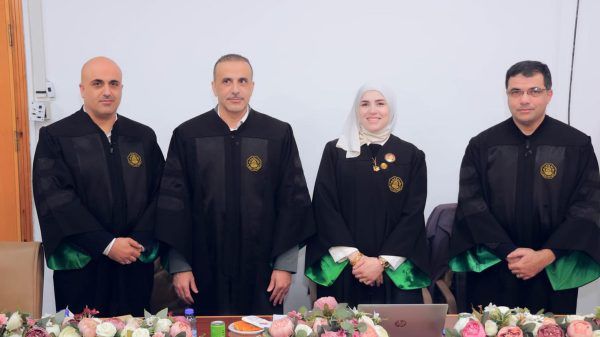
Is “One” Unique?
This is not an essay about Vanity! Rather, what follows is a brief journey into the writings and minds of Aristotle and three medieval philosophers or thinkers, one Muslim, by the name of al-Kindi, one Christian by the name of Yahya Bin Adi and one Jew, by the name of al-Muqammas. You are at liberty to consider this a political journey, but it is really a journey beyond politics.
The journey begins with Aristotle’s Metaphysics, for whom the being one (or to be one) was just as problematic as being (or to be)- indeed was so problematic he proclaimed such issues to be the most obtuse in philosophy.
We can immediately get a sense of what the problem is when we ask ourselves the question whether these two (that is, to be and to be one) are the same or not, or whether, more specifically, something’s being one adds anything to that something’s being. Put differently, is there any difference to speak of between something being, or existing, and that something being- whatever else we might say about it- just that one thing? One could already see that the very same problem is already encountered in invoking the word “something”, or the expression “a thing”. Wouldn’t we simply be repeating ourselves if we said that some thing is one thing –that is, if we already identified it in our minds (or by our minds) as something which is describable as one thing? And if we would not be repeating ourselves, what exactly would we be adding?
I chose as the title of this presentation the question “Is ‘one’ unique?”, deliberately placing the word ‘one’ in quotations, by way of consciously shifting our focus from the so-called external world to that of language, in order precisely to allow ourselves to try to make out a difference between something existing and that thing being called or described as one, or as having an attribute or a quality of being one. By so highlighting it as non-primary, or as a non-subject, or by so detaching it from the primary object or substance itself in the external world, we can at least try to allow ourselves to regard such an appellation or description or quality or attribute as simply being on a par with the less problematic “being blue”, for instance, or being octagonal in shape, or as occupying a particular time-space coordinate. As a next step, we can allow ourselves then to proceed to a second-level discourse, where we can begin to consider how to view or to describe this one-ness, exactly as we might pronounce an opinion on the quality of blue-ness a particular painting or wall has, by saying this one-ness, for example, is unique, as we might say this blueness is bright or fluorescent, whereas that is less so, or is not so at all. But would we really be justified in taking such steps, or in our so regarding the appellation or attribute of being one? Can we really view one-ness as we view blue-ness? Can we detach, in other words, the one-ness of something from it the way we can detach in our imagination the blueness of a wall from it?
Our last question invokes our initial problem: can we really separate (or is there a separation) between objects out there in the world and their being one each? Isn’t the very fact they are (or we see them as) separate objects the same as their being (or as our seeing them as) one each? After all, I can imagine this wall having a color other than blue. But I do not even know how to begin to imagine this wall not beinga this. (Imagining this bit of structure as part of a larger edifice rather than as a wall is another exercise altogether, and it begs the question, in this context, of whether there is, independently of the observer, a this to imagine anything about).
We are again therefore confronted with the question whether being and unity (the being, and the being a one or a this) are the same or different from one another, and what -if they are different from one another- the difference between them might be. Aristotle tells us that, besides their being the hardest and most necessary of all things for having knowledge, people have differed over how to regard them –whether as ultimate and primary, as Pythagoras and Plato have regarded them, or as secondary elements, having or subsisting in a more basic substratum as the natural philosophers -for example Empedocles, who saw them as aspect of eros– seem to have viewed them. In all cases he further reminds us that those philosophers, like Parmenides, who postulated that unity-itself and being-itself are primary have come to the even more confounding conclusion –perhaps even have had to come to it- that everything there is, is one, and that is being.
As is his way, having pointed out what others have said about his subject of inquiry Aristotle then proceeds in a step-by-step and studied manner to enumerate for us the different ways we use or understand the appellation “to be one”, beginning -most importantly for our later discussion- with the distinction he makes out between what is one “by nature” and what is one “by accident”. But even with Aristotle’s acuteness of mind, the ultimate obtuseness of the inquiry (whether being one and being are the same or different) not only remains, but it grows further as God comes into the picture, shedding, as we shall see, philosophical speculations beyond where Aristotle himself might have ventured.
In particular, no sooner do we reach the medieval Islamic period –and the primarily Arabic philosophical milieu- than we find ourselves immediately confronted with these far-reaching philosophical speculations, inspired on the one hand by an already firm religious belief regarding monotheism, or God’s one-ness, but already being challenged, on the other hand, by a very robust pre-existing Christian controversy and concluding claims concerning the matter –as, for example, that expressed in an epistle on Aristotle’s treatment of unity (documented in the Fihrist of Ibn al-Nadim) by the Athenian Ammonios Hermiae, who lived in the sixth century (d.520A.D.). It was naturally Muslim theologians who devoted their energies to the defense of the monotheist cause against all kinds of pre-existing and contemporaneous belief systems, religious and otherwise, including dualism and trinitarianism, ancient and modern. Our three interlocutors dealt with the question of what one means, on the other hand, within the framework of what could be viewed as the philosophical tradition, by which is meant specifically the received tradition of Aristotle and his commentators, and the terms of reference they used. Al-Kindi, the so-called first Arab philosopher, devoted at least two separate works to the issue of what it is to be one, or what one means, in one of which he seems to have directly addressed trinitarianism. Unfortunately, the work carrying the title “On One-ess” is not extant, but his extant work “On First Philosophy” treats of the matter quite extensively and, as I shall show, also quite shockingly.
It should go without saying that the shock I mean is purely philosophical, and retrospective, or one that can presumably only be felt by a de-contextualized philosophical reading of the relevant texts. Although the puzzling claim does not so much have to do with whether God can or cannot be three, yet it is precisely through invoking al-Kindi’s counter-claim to trinitarianism, or of what it means for God –and, by implication, for everything else- to be one that the philosophical shock which is meant can be felt. But to appreciate his counter-claim, it may be best to begin by explaining the claim itself. In his epistle on one-ness –which may have been influenced by the aforementioned epistle by Ammonios- our second interlocutor, Yahya Bin Adi, a Trinitarian Jacobite, explicitly sets out to challenge his Nestorian co-religionists as well as Muslim thinkers (such as al-Kindi) on what it means for God to be one by stipulating that, considering the six different manners Aristotle already enumerated of what one or one-ness might mean -God can be shown to be both one as well as many in accordance with one of those manners, namely the manner in which what we call one is identified to be so by definition. Simply, Yahya argues that if an object’s being identified as one is identified as being so specifically by means of a definition, then that same object can also be picked out by another definition, such that the object can both be one and more than one at the same time, though in different respects. It is questionable how faithful to Aristotle Yahya is being here, and indeed, it is significant that he does not eventually insist on using the term “definition” in this context, and suggests also using the term “descriptive phrase”, as though these two terms were inter-changeable. On his part, Aristotle does seem at one stage to speak about two objects being called one if their respective essences are picked out by two definitions indivisible from one another. This almost seems to substantiate Yahya’s point. But here, Aristotle is referring by way of example to planes or lines or figures that can change in size. These objects, arguably, are one in form, though they are different instances of that form, and their one-ness, therefore, can be argued to be a one-ness of species, rather than of definitions.
Be that as it may our third interlocutor, the Jewish al-Muqammas, on whose extant texts on the question of one-ness we should defer to my colleague, Sara Stroumsa, squarely takes on Jacobite, and Melkite trinitarianism, in his own treatise on the one-ness of God, arguing that two of the common meanings of one-ness (viz., that something can be understood as being one both qua being itself as well as qua the acts that proceed from it) are meanings which can also explain what we mean by one as this applies to God, while other meanings, such as something’s being one qua its genus, or its species –two other manners of being one as first enumerated by Aristotle- would not apply in God’s case, as both of these presuppose the compositeness of the object being identified. It is arguable that Yahya’s manner of defining the one-ness of God escapes al-Muqammas’s criticism, as his point is that in the case of God it is the definitions that are more than one, but not God or the thing-itself; or put differently, his point is that the thing-itself is one thing, but it happens to have (in the case of God) three definitions. This is arguably different than the case of the species, where indeed the object-itself is admittedly a composite.
Actually, Yahya would concur with al-Muqammas that God’s one-ness can also be understood as being so both qua God being Himself and qua God’s Acts. He would call these aspects “modalities” or “modes” of one-ness, over and above its different meanings which were already spelled out by Aristotle, and which include his preferred meaning of one-ness (as well as many-ness) for God, viz., the He is so “by definition”. Al-Muqammas, for his part, inclines towards concluding that the only acceptable means of explaining what it is for God to be one is for Him to be one qua being Himself, or unique, as well as qua His acts, meaning that there is none other like Him, nor any similitudes of any of His Acts.
Yahya has an amusing argument to challenge this way of understanding what one means as said uniquely of something, viz., that there is none other like it, by saying, inter alia, that this very way of setting something apart also sets apart whatever other object there is that is being set apart from it by identifying this second object as being different from the first, so that there will by necessity be another object sharing at least the attribute our first object has, namely, the attribute that it does not share anything with the first object! Indeed, more than one object can be picked out by what we assumed was a unique description.
Of course, there is no way to get over the rational wonderment one can always feel at everything to do with God, including, for our purposes here, the issue of whether and how one can make sense of trinity, or indeed, of one-ness. The late Cambridge philosopher Bernard Williams, in referring to the so-called “Tertullian paradox”, comes closest perhaps to offering an account –also arguably paradoxical- of what it means to use as justification for an irrational belief –as in an article of faith- that it significantly lacks any rational justification: that the very justification is itself the absence of any rationale behind it! This claim might seem to be suitable where God is concerned. But the wonderment I am referring to here -the shocking element- does not have to do with a belief about God, but is the belief al-Kindi for one has us have in something about the created world itself, resulting from his strongly-held monotheistic view that, of all beings, God alone is truly one. In pursuit of the explication of how God is indeed and truly one, he finds himself adopting the view –quite extreme, in a way- that only He is so. That God’s one-ness, in other words, is unique. Not only is God not more than one. Of all things, He alone is truly one. Only in His case are being and unity inseparable. In everything else, they are separable. This claim –that they are separable- is what I called philosophically shocking.
I must add straight away that al-Kindi does not present us with an argument for his position. He simply states it, repeatedly. Nor does he address its implications on our understanding of the world. He leaves us with having to contend with the implications of his thesis by ourselves.
The other monotheist in this triad, or al-Muqammas, does not go to that length in his articulation of his position. Although in his view God is one, the category itself of being one qua being itself is not, for him, unique. It is a category that allows us to understand what it is for God to be one, but it is not true only of Him. Likewise, the category of being one, singled out by multiple definitions or descriptive phrases –Yahya’s preferred meaning for one in God’s case- is not a category that is argued to be uniquely true of God. On the contrary, it is argued to be a common means of describing objects in the world. In fact, both Yahya and al-Muqammas do not choose to pick out definitions or descriptions or meanings that are unique, or cannot be used in the case of beings other than God. Rather, they both choose meanings for one-ness that are among those in common use, picked out or drawn from Aristotle’s initial list, and they each argue that it is one or the other of those that are most appropriate to use in the case of God. Not so al-Kindi, who takes the matter further by claiming that God’s one-ness is inseparable from Him, but the one-ness everything else in the world has, or is categorized or described by, is accidental.
Before addressing the implications of al-Kindi’s claim, who seems to break a general pattern by insisting that God’s one-ness is unique, and who, by breaking this pattern, invites us to view the world in a totally different light, let me jump ahead in time and shift focus as I do this just a bit to a paradox associated with another Jewish interlocutor – the Baghdadi Ibn Kammunah- as he took to task the argument –associated with some post-Suhrawardi philosophers, and initially derived from the Avicennian distinctions between necessary and possible, and essence and existence- that God’s existence can be proven from the very meaning of God’s essence as a necessary being. Addressing the by-then established claim associated with Avicenna that what is necessary of existence by virtue of itself, or God, is a primary notion, and this claim’s further development in the later tradition that this is a proof for the existence of God by extrapolation, or by proceeding from the very meaning of the concept of necessariness itself, Ibn Kammunah is held to have argued that such an extrapolation can be made with regard to more than one being if we stipulate that the object of our reference also belongs in the world of meanings -or that it ceases in other words to be unique; and that it ceases on the other hand to be exhaustive as a description of an object in the external world once we claim that this, rather than the world of meanings, is its space of reference –that such objects come to require additional specifications to tell them apart. This will immediately tell us that such objects are composites, and none of them can therefore be God, a supposedly simple substance. Either way, what we seek to prove as God turns out to be more than one.
From our point of view the Ibn Kammunah paradox (which may remind us of Yahya’s challenge to one interpretation of what one means) is interesting insofar as it sheds light on the meaning and significance of unique reference. His point of course is that so long as the reference one uses (in this case “necessary by itself”) does not pick out something in the real-world, but is restricted to the world of meanings or the mind, it can pick out more than one object: more than one such object could be regarded as a self-sufficing, or a necessary-by-itself being. In one respect, this observation is almost the converse of Leibniz’s famous “identity of indiscernibles” principle. To pick out God, the reference has somehow to be unique. Applied to our case, our use of the description “one” as said of God -to pick Him out- also has to be unique. But how could this be made so?
al-Kindi’s bold and unsubstantiated claim is to stipulate that it is so, it is unique: that used of Him it has a special meaning, which is its original, or real meaning (bi’l-haqiqa). Used of everything else, it has a metaphorical or analogical meaning (bi’l-majaz).
It is not entirely clear that al-Kindi’d distinction would avoid Yahya’s observation that, if one-ness were to uniquely pick out the object being referred to (the ‘thing itself’) –in this case, God- just as a name might, then we would have to acknowledge the presence of two things, one-ness and the thing-itself, and we would have then to inquire which is prior to which, one-ness or the thing-itself. Yahya (as well as al-Kindi and al-Muqammas) use the term ‘the thing-itself’, or al-dhat, without troubling with our initial question of whether ‘the being one’ is the same or not as the ‘thing-itself’. Their main concern in this context is just to distinguish between what might belong to or be possessed by the thing-itself by virtue of being itself, and what might belong to it or be possessed by it as an accident. All three would further agree to distinguish between ‘the thing-itself’’ and being a substance, the latter being part of the pair substance and accident, with al-Muqammas, for one, clearly rejecting the treating of God as a substance, partly on account of the pair-hood just mentioned. Of the three, only Yahya would consider God to be a substance (though he would point out that this substance is invisible), and in referring to God would use ‘the thing-itself’ and ‘substance’ interchangeably. But rather than claiming that one-ness, as applied to God, applies to Him as to the thing-itself, and belongs to Him and is possessed by Him in this manner, al-Kindi claims that it belongs to Him or is possessed by Him in its true meaning (bi’haqiqah), rather than metaphorically, which is how it belongs to everything else. For him, it turns out, nothing naturally exists as an individual. I must immediately point out that I am using the word “naturally” (tabi’i) here as it is commonly used, or as we commonly understand it, in contradistinction to the way al-Kindi uses it in the text we are considering, since al-Kindi subsumes what he calls natural individuals under the category of being so in the metaphorical rather than the real sense; that is to say that while he points out the distinction that exists between what we take to be natural individuals such as persons and what are artificial individuals such as houses, he nonetheless submits that the unity of natural persons is in fact accidental to them, and is a posit, and does not therefore belong to them in reality.
When Aristotle had first distinguished between something being one “by nature” and its being one “by accident” he did so in what one might call a leisurely or neutral way, not seeking, the reader feels, to prove a preconceived article of faith. It is therefore not surprising, in such a context, to see him referring to something being by nature more one than another (e.g. the shin or the thigh more than the leg, because the movement of the leg need not be one); or even being both one and not one (e.g. as in a bent line which has an angle, whose movement can both be simultaneous or not); or referring to a circle as being, of all lines, most truly one, or calling those things whose substance is one either in form or in continuity or in definition as being the things that are primarily called one. As he scans through these different shades of meaning, Aristotle seems to engage in a journey of thinking out loud, of trying to ferret out all the different shades of meaning of one-ness, or unity, distinguishing as he does so between things in the world whose unity comes about from an extraneous cause, like someone being a musician, and those things whose unity seems to be intrinsic to the sorts of things they are, like lines or planes or substances or what today would be referred to by so-called mass terms, like water or wine. We find the same or similar distinctions presented in the works of our three interlocuters, with both Yahya and al-Muqammas seeming to take more seriously their signification of the underlying generic distinction between what is one by nature and what is one by accident. Al-Kindi, however, and after going along with the Aristotelian scheme, surprises his readers by suddenly breaking off and beginning to present these distinctions as being of a second-class order of importance, precisely by claiming that all of these unities which are described as being intrinsic are in fact accidental, and metaphorical, and that real unity belongs to God alone.
‘One’, al-Kindi tells us, uniquely refers to the One.
This claim, as we already said, leaves us in something of a philosophical suspense. We seem to be called upon to believe that the individuation of everything in the world, and with which we are familiar in our common lives, is somehow contingent –that being and being one are different, or that the units of discourse making up our world (whose existence, by the way, is not being put in doubt) could be different. But what could this conceivably mean?
Al-Kindi does not tell us. He leaves us with having to imagine what the implications of his claim on our world might mean. Indeed, his own focus is on God, where he believes philosophy’s eyes should be focused. But how could we understand him? One way to understand him would be to take as given the actual scatter of the different unities there are in the world. In this case, suppose I see two birds fly over me in the sky. I can say what I just said, that I see two birds. Or I can say, I see a twird flying. Are they two birds, or is it one twird? One version would have it that the actual units out there in the sky (what I would be pointing at each as a this), besides being “out there” to be seen and individuated as single entities,are also genuine and independent unities. But on another version it could be claimed that these are not genuine units, but scatter from which we as observers can make out birds, twirds, thwerds, fwerds, and so on. We can see a forest or a clump of bamboo culms as in Kyoto or in Maui as the extended body of a single plant; or we can see a plethora of different bamboo stalks. When we divide the world up as we do –we can imagine al-Kindi telling us on this version- this is not because this is how it is divided up in itself, but because this is how we, probably through the agency of God, have come to see it useful, or simplest, or whatever, for us to divide it up.
But this is only one way of understanding al-Kindi. The other way is to suppose that what he meant was that our actual world could have been different…that instead of there actually being different single birds, there could have been actual different single twirds, as two-headed, four-winged and quadruped avians, or thwerd or fwerds, and so on; or that the very material from which the world is made up could have been molded in entirely different shapes as ultimate unities, it having been chance, or the will of God, that the actual world is as it is.
Al-Kindi’s confounding but undeveloped pronouncement on unity later finds expression in Avicenna, who manages through developing this and related themes- such as the distinction between what is necessary of itself and what is necessary only by some cause outside of itself, thereby reducing the what-ness of an object to the same contingent status as its that-ness– to clear a philosophical path between Aristotelian and Platonic world-views, thereby presenting us with an alternative scheme with which to understand the world, a whole system which, detaching itself from the ontological anchorage of both primary substances as well as Forms, weaves the shocking elements of Al-Kindi into an original (Eastern) tapestry.
Sari Nusseibeh
Al-Quds University
* Paper presented on the 22nd September 2011 at the University of Geneve on the occasion of the inauguration of the program in medieval Jewish thought.







